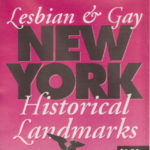
NYC LGBT Historic Sites Project: Digging Into the Story of NYC’s First LGBT Preservation Efforts
June 1, 2018 | Brad Vogel, NYPAP Executive Director
In 1994, the first U.S. state was still ten years away from legalizing gay marriage. Open homosexuality still led to discharge from the military under Don’t Ask Don’t Tell. And yet, in New York City, a nascent band of intrepid figures had already coalesced and begun the work of uncovering, documenting, and celebrating historic sites important to the LGBT community.
To celebrate the 25th anniversary of the pivotal Stonewall Riots that year, a group “decided to put together a map and guide of lesbian and gay sites in New York City, focusing on Greenwich Village, Midtown, and Harlem,” recalls Andrew Dolkart, adding, “Amazingly, this had never been done before! We believe that this was the first such map in the nation.”
These preservationists, operating as a sub-group of the Organization of Lesbian and Gay Architects + Designers (“OLGAD”), crafted a document called A Guide to Lesbian & Gay New York Historical Landmarks. Featuring an image of the famous Angel of the Waters statue in Bethesda Fountain in Central Park (sculpted by Emma Stebbins) on its cover, the guide sought to provide a map and context for historical sites of importance to the lesbian and gay movements.
“There were so many LGBT individuals in the architecture, design, historic preservation, and cultural heritage professions,” notes Jay Shockley. “Many of us were working to research, celebrate, and preserve other communities’ cultural heritage, but who was looking towards ours? It had to be done by the LGBT community itself.”
The guide’s map did not materialize suddenly from thin air, however. It represented the fruits of an ongoing effort that had started earlier. “The map was a wonderful opportunity for the OLGAD preservation committee to put into practice what we had been discussing since 1992,” Ken Lustbader remembers. Lustbader joined the effort because he was busy at the time with his thesis—which explored the intersection of historic preservation and LGBT sites, using Greenwich Village as a case study. “I had felt pretty isolated working on my own, not knowing that there were a few others in New York City thinking about LGBT place-based history,” Lustbader said, noting that he was inspired by historian George Chauncey’s research on gay New York history.
Dolkart recalls that another OLGAD group, Repo History, made up largely of artists, designed plaques relating to lesbian and gay history and related sites in Greenwich Village. These were installed on lampposts for a few months at the time of the Stonewall 25th.
But the OLGAD map, being a little less ethereal, proved to be a quiet, continuing watershed of sorts. Action followed.
“Andrew Dolkart included several LGBT sites in the published guide to NYC Landmarks,” Shockley noted, “and Gale Harris and I began, tentatively at first,to incorporate LGBT history into officialLandmarks Preservation Commission designation reports, in projects to which we were assigned, where appropriate.” As far as anyone can tell, this represented the first such effort at a local landmarks commission in the United States.
Over the remainder of the 1990s, the outgrowth of the OLGAD map kept the trio busy. As Dolkart recalls of the group’s desire to continue, “The first project that grew out of this was the successful completion of the National Register nomination and then the National Historic Landmark nomination for Stonewall [Inn] itself.”
The trio of Dolkart, Shockley, and Lustbader was part of a panel discussion at the National Trust 2011 conference in Buffalo and finally, in April 2014, “we met to discuss a more comprehensive project since the concept of LGBT cultural heritage had begun to take root in other cities,” recalls Lustbader. But Shockley noted that it took some time; even as the Landmarks Preservation Commission continued to amass LGBT history in landmark designation reports, the Commission didn’t designate an LGBT landmark specifically for LGBT reasons until after fie other cities in the U.S. had done so.
“I was the firstperson to publicly, and internally, advocate for Stonewall to be designated,” Shockley recalls, “Stonewall was not designated a NYC Landmark until 2015, and is the only such LGBT-related Landmark.” The landscape remained a rather harrowing one.
Then, when the National Park Service introduced its grants for the study of under-represented communities, the trio jumped at the chance to apply. “Receiving the first grant set us off on establishing the NYC LGBT Historic Sites Project, something that we had long hoped to establish,” said Dolkart. Today, Dolkart, Shockley, and Lustbader, the three co-founders of the Project, all remain very active in the effort.
“One of the most important aspects of the Project is to raise public awareness of LGBT history through the documentation of these historic sites,” said Amanda Davis, Executive Director of the Project. “It’s virtually impossible to rally the public and elected officials around a campaign to protect sites from demolition/extensive alterations if most people are unaware that this history even exists.”
Beyond raising awareness and providing context, the Project has also pushed for official,legal recognition of LGBT sites. Those efforts at recognition have taken place at the city, state and federal levels. “To date, we have completed four landmark nominations—three new and one a revised nomination. The new nominations are Julius’ Bar, Caffe Cino, and Earl Hall at Columbia University; the revised nomination is for the Alice Austen House on Staten Island,” said Dolkart. “In addition, we have been highly supportive of the larger effort to have the Walt Whitman House in Brooklyn designated as an individual landmark.”
The groundbreaking work of OLGAD in the early 1990s continues to resonate in new ways in a changed societal landscape. The Project’s work moves forward with a strong sense of mission. “We’re hoping to educate the public on what definesLGBT cultural heritage beyond the obvious Stonewall history and showcase the sites that reflect the community influence on American cultur,” Lustbader emphasized.